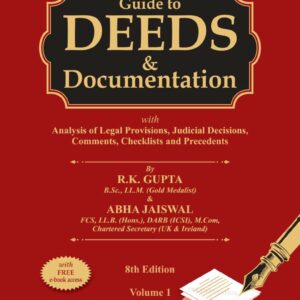Commentary on Hindu Succession Act 1956 | Neelam Kumar Jain | 2025 Edition | Bharat Law House | Best Publication |
Introduction
The Hindu Succession Act, 1956 is an Act relating to the succession and inheritance of property. This Act lays down a comprehensive and uniform system that incorporates both succession and inheritance. This Act also deals with intestate or unwilled (testamentary) succession. Therefore, this Act combines all the aspects of Hindu succession and brings them into its ambit. This article shall further explore the applicability, and the basic terms and definitions and the rules for succession in the case of males and females.
The rules of Hindu personal law are heavily dependent on the two schools popularly known as Mitakshara School and Dayabhaga School. According to the Mitakshara School, there are two modes of devolution of property. These are:
- Devolution by survivorship
- Devolution of succession
The rule of survivorship is only applicable with respect to joint family property or coparcenary property. On the other hand, succession rules apply to separate property held by a person. However, the Dayabhaga school places emphasis on succession as the only mode of devolution of property. The article discusses the rules of succession under the Act and gives an overview of the whole Act. It also describes the devolution of coparcenary property along with the major changes brought by it.
Applicability
Section 2 of this Act lays down the applicability of this Act. This Act is applicable to:
- Any person who is Hindu by religion or any of its forms or developments, including a Virashaiva, Lingayat, or a Brahmo, Prarthna or Arya Samaj follower.
- Any person who is a Buddhist, Sikh, or Jain by religion.
- Any other person who is not a Muslim, Christian, Parsi, Jew, unless it is proved that such person would not be governed by Hindu law or custom.
- This Act shall also extend to the whole of India.
However, this Section shall not apply to any Scheduled Tribes covered under the meaning of Article 366 of the Constitution, unless otherwise directed by the Central Government by notification in the Official Gazette.
Who qualifies as a Hindu, Sikh, Jain or Buddhist
- A legitimate or illegitimate child, where both of his parents are either Hindus, Buddhists, Jains or Sikhs.
- A legitimate or illegitimate child, one of whose parents is a Hindu, Buddhist, Jain or Sikh and is brought up as a member of the tribe, community, group or family to which such parent belongs.
- Any person who is a convert or reconvert to the Hindu, Sikh, Jain or Buddhist religion.
Basic terms and definitions
Agnate
Section 3(1)(a) defines ‘agnate’. A person is said to be an agnate of another if the two are related by blood or adoption wholly through males.
Cognate
Section 3(1)(c) defines a person to be a ‘cognate’ of another if such a person is related to the other by blood or through adoption but not wholly through males.
Heir
According to Section 3(1)(f), ‘heir’ is any male or female person, who is entitled to receive the property of the intestate.
Intestate
According to Section 3(1)(g), a person who dies without leaving behind a will is referred to as intestate.
Related
According to Section 3(1)(i), ‘related’ means the relationship between kin( kinship), which should be legitimate. Illegitimate children shall be deemed to be related to their mother and to one another, and their legitimate descendants shall be deemed to be related to them and to one another.
Features of the Act
The importance of the Act lies in the fact that it provides uniform rules for succession and reduces the conflict that arose due to confusion over different rules based on the ideas of two schools. Other features of the Act are:
- It makes a uniform system of inheritance and devolution of property that is equally applicable to areas of Mitakshara and Dayabhaga school. The applicability of the Act is explained thoroughly under Section 2 of the Act. However, it does not apply to people governed by the Special Marriage Act, 1954.
- Another important feature of the Act is its overriding effect given under Section 4. It abrogates all the earlier laws, customs, rules, etc that were applicable to Hindus with respect to succession. Any Act or law that is inconsistent with the provisions of this Act will be ineffective.
- It has also abolished the concept of impartible estate and its succession by special mode.
- Earlier, the rule of survivorship in coparcenary property was only applicable to male heirs. Female heirs were not recognised and given the right to inherit by survivorship. But after the enactment of the Act, there has been a change in this concept. Now, if a male dies intestate, leaving behind a female heir, the property would devolve according to the provisions of this Act and not the rule of survivorship.
- The Act provides order of succession based on the doctrine of propinquity, i.e., nearness or closeness of blood, and gives four different categories that are:
- Class I heirs
- Class II heirs
- Agnates (people related to each other either by blood or adoption only through males)
- Cognates (people related to each other either by blood or adoption but not through males).




Reviews
There are no reviews yet.